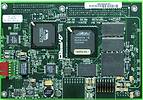

Ampro Computers has announced the EnCore M2, the first RISC-based entry in its new EnCore family of high integration embedded processors. Ampro combined Alchemy Semiconductor's 400 MHz Au1000 chip, a MIPS32-compatible processor, with a PCI-bus controller, SDRAM memory and additional peripherals to provide a complete standards-based CPU subsystem on a small form-factor module. Ampro also announced two new Intel Architecture, IA, (x86) members of its EnCore family of embedded processors, the 486-based EnCore 400 and the Pentium III-based EnCore 700 modules.
EnCore is a small, high-integration embedded processor, designed to plug into application-specific logic boards. EnCore modules relieve developers of most of the processor-development overhead in creating embedded systems. The EnCore module communicates with a custom logic board via a PCI interface and standardised I/O signals, essentially without regard to processor architecture. Processor integration, verification and temperature testing have already been taken care of by Ampro.
Encore M2
"The EnCore M2 can shorten product development by up to 40 weeks and EnCore processors speed development projects by eliminating the need to bring up and debug the CPU portion of the design as well as eliminating the need to configure and port an operating system to a custom CPU design," said Joanne Williams, President and CEO of Ampro. "And since all EnCore processors are functionally and electrically pin-compatible, the new EnCore M2 enables embedded designers to create a single application board and trade off the performance, power consumption and cost benefits of MIPS32 versus x86 designs."
"The EnCore M2 will accelerate many projects currently being designed to operate using the MIPS32 architecture," said Jim Moore, President and CEO, of Alchemy Semiconductor. "The Au1000 is targeted to meet the communications market demand, whose products operate on the outer edge of the Internet network. The EnCore M2 allows these products to reach market with the Au1000 faster than ever before."
The EnCore product family now provides a choice of a MIPS32 highly integrated processor or three Intel Architecture CPUs (see below). Each module provides a processor along with a rich set of standardised peripherals and I/O. EnCore I/O include: Ethernet, serial, parallel, USB and sound. Also included are program storage with a choice of flash, IDE or floppy. Some EnCore modules provide 2D/3D graphics and flat panel controllers. EnCore M2 is OS ready to run VxWorks, and Linux.
The EnCore M2 is rated at 480 Dhrystone MIPS and typical power consumption of the entire module is less than 2 W. The module features a 33 MHz PCI Bus Interface and provides the functionality of a complete embedded CPU subsystem in a 100x 145 mm format.
Intel Architecture modules
Ampro's two new Intel Architecture EnCore members, the 486-based EnCore 400 and the Pentium III-based EnCore 700 modules, extend the range of the EnCore family further across the IA (x86) price/performance spectrum. "The availability of a wide price/performance range of EnCore modules enable developers to build a complete and comprehensive product line from the same design. It can incorporate different modules with different price points in their end product while using the identical application-specific logic board. Future upgrades are now easier to execute as well," comments Williams.
Within the EnCore line, embedded developers can now select from a 133 MHz 486, 266 MHz Pentium, 500 MHz Celeron, 850 MHz Pentium III or 400 MHz MIPS32 processors. Each module provides a choice of a RISC or CISC CPU along with a rich set of standardised peripherals and I/O. EnCore I/O include: Ethernet, serial, parallel, USB and sound. Also included is program storage with a choice of flash, IDE or floppy.
The EnCore 400 module is based on ST's new STPC Atlas microprocessor running at 133 MHz. Like all EnCore modules, the EnCore 400 provides two serial ports, EPP/ECP parallel port, two USB UHCI ports, PS/2 keyboard and mouse interfaces, floppy and Ultra/DMA 33 IDE controllers, 10/100 BaseT Ethernet interface and an AC97 audio interface. It supports from 16 to 128 MB DRAM.
The EnCore 700 module is initially available with either a 500 MHz lower cost Mobile Celeron or 850 MHz high-performance Mobile Pentium III processor. Each EnCore 700 incorporates the new Intel 815em chipset and provides two serial ports, EPP/ECP parallel port, two USB UHCI ports, PS/2 keyboard and mouse interfaces, floppy and Ultra/DMA 33 IDE controllers, 10/100Base-T Ethernet interface and an AC97 audio interface. EnCore 700 supports from 16 to 512 MB DRAM.
Both modules interface to an application-specific logic board using a 33 MHz PCI bus, and include a 2D graphics controller which provides both CRT and TFT flat panel video interfaces.
For further information contact Electronic Products Design, (012) 665 9700.

© Technews Publishing (Pty) Ltd | All Rights Reserved